

Breeding Better Beans
Page 20

PROVEN PERFORMANCE
The only Eastern Corn Belt based Seed Company with 4 National and 31 State Winners in the NCGA Yield Contest.
REGIONAL GENETICS
Elite Corn Hybrids and Soybean Varieties developed, tested and bred exclusively for the Eastern Corn Belt’s unique growing conditions and soil types.
REGIONAL TESTING
Extensive Corn and Soybean replicated testing program in the Eastern Corn Belt tested at 100+ testing locations.
REASONABLE PRICING
Industry leading Corn Hybrids and Soybean Varieties at everyday farmer-friendly prices.
Celebrating 25 Years Seed Consultants, Inc.
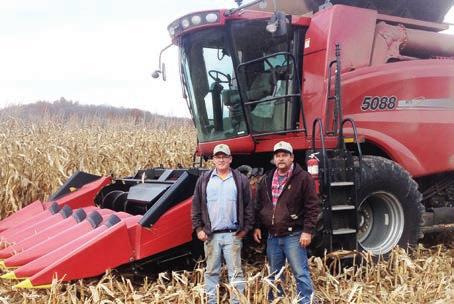
“Seed Consultants offers many seed choices for our farm. Their corn hybrids and soybean varieties out yield the competition. We love the excellent service our knowledgeable Area Seedsman provides too!”
OAKLAWN FARMS Frazeysburg, Ohio
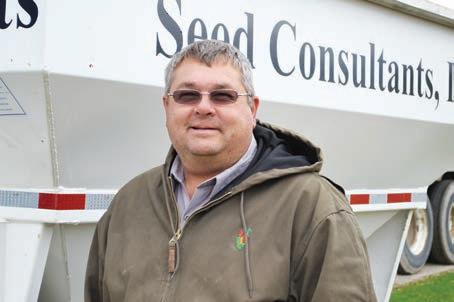
“Seed Consultants performs on my farm. Their corn hybrids and soybean varieties win my strip plot year after year! They are a tremendous value to my farm!”
JERRY SCHLAGENHAUF Bluffton,
Indiana

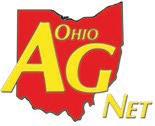
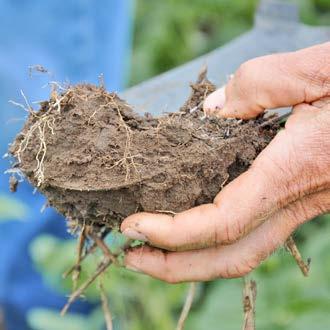

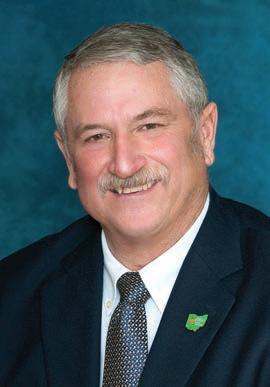
Jerry Bambauer
Ohio Soybean Association Chairman Auglaize County soybean farmer
A Letter From the Chairman Perspective
Summer is officially here which means planting is wrapping up for most parts of the state. The weather this year is much warmer and dry compared to the conditions we saw last year. I saw the U.S. Department of Agriculture reported that 46 percent of Ohio’s soybean crop was planted by May 17, which is above the five-year average and more than double where we were last year.
It has been a busy few months of meetings for the Ohio Soybean Association (OSA). I was recently in Washington D.C. with OSA and the American Soybean Association (ASA) for ASA’s annual spring board meeting. The discussion focused on issues facing the soybean industry including trade, biotechnology and biodiesel. Soybean farmers from each of ASA’s 26 state and regional affiliates visited the offices of their House and Senate members, and ASA’s Executive Committee met with Alex Taylor, deputy undersecretary of farm and foreign agricultural services at the U.S. Department of Agriculture, to discuss trade issues.
It’s important that soybean farmers maintain relationships with our legislators in Washington and Columbus. OSA farmer leaders work hard to stay on top of bill movement, regulatory rules and other changes to policy that are moving through our state and federal government. And when something comes up that will affect your bottom line, we’re there in the offices of your legislators to ensure your voice is heard.
For more information about OSA and the benefits of membership, visit www.soyohio.org/membership
Sincerely,

Jerry Bambauer
OSA Chairman
President
Tommie Price, Putnam County
First Vice President
Adam Graham, Logan County
Vice President
Jeff Roehm, Highland County
Treasurer
Todd Hesterman, Henry County
Secretary
Allen Armstrong, Clark County
Chairman
Jerry Bambauer, Auglaize County
Trustees
Jeff Adams, Young Leader Ex-Officio
John Buck, Marion County
Amy Sigg Davis, Warren County
Bret Davis, Delaware County
Dave Dotterer, Wayne County
Caitlyn Heimerl, Industry Affiliate Ex-Officio
James Heimerl, Licking County
Scott Metzger, Ross County
Jerry Meyer, Industry Affiliate Cargill
Ryan Rhoades, Marion County
Bruce Simmons, Medina County
Jeff Sollars, Fayette County
Andy Stickel, Wood County
Kerrick Wilson, Preble County
American Soybean Association Board
Representatives
Bret Davis
Jerry Bambauer
Jeff Sollars
Staff Credits
Adam Ward-Publisher
Jennifer Coleman-Editor
Katie Bauer-Contributing Editor/Staff Writer
Kayla Weaver-Contributing Writer
Donovan Harris-Design Director
Brent Warren-Senior Designer
Barry Falkner- Photo Quality/Proofer
Tony Green-Advertising Production
Ohio Soybean news is published six times a year by the Ohio Soybean Association, 918 Proprietors Rd., Suite A, Worthington, OH 43085. Phone: 614-476-3100. For address corrections contact Ohio Soybean News at 918 Proprietors Rd., Suite A, Worthington, OH 43085.
Web address: www.soyohio.org
E-mail: cdeboard@soyohio.org
Comments and statewide news articles should be sent to the above address. Advertising space reservation must be made by the first of the month preceding publication. In consideration of the acceptance of advertisement, the agency and the advertiser must, in respect of the contents of the advertisement, indemnify and save the publisher harmless against any expense arising from claims or actions against the publisher because of the publication of the content of the advertisement.
For Advertising Sales Contact: Matt Herman- (612) 812-5833
matt.herman@dtn.com
EVERY DROP OF BIODIESEL DRIVES MORE VALUE FOR YOUR SOYBEANS.
2 BILLION GALLONS OF BIODIESEL
WERE PRODUCED NATIONALLY FROM SOYBEANS IN 2013, A NEW RECORD.

This represents a growing component of the annual U.S. on-road diesel market of about 35-40 billion gallons. Consistent with projected feedstock availability, the industry has established a goal of producing about 10% of the diesel for the transportation market by 2022. • There are currently about 200 biodiesel plants across the country — from Washington state to Iowa to North Carolina — with registered capacity to produce
To learn more about the Ohio
62,000 JOBS ACROSS 200 BIODIESEL PLANTS NATIONALLY.

some 3 billion gallons of fuel.
• The industry is supporting more than 62,000 jobs, generating billions of dollars in GDP, household income and tax revenues. • OSC has worked closely with the National Biodiesel Board to drive development of additional uses for biodiesel. One example: home heating fuel. New York City is already the nation’s largest municipal user of biodiesel and recently implemented a 2% biodiesel blend mandate on heating oil.
Gov. Kasich Signs Senate Bill 1
On April 2, 2015, Gov. John Kasich signed Senate Bill 1 into law. The Ohio Soybean Association (OSA) worked very closely with the members of the legislature and administration to make sure the bill utilized sound scientific practices. OSA worked with legislators to ensure the 4Rs of nutrient application are the foundation for any regulation on how commercial fertilizer is applied. OSA supports the new bill and sent out the following statement:
“The Ohio Corn and Wheat Growers Association and the Ohio Soybean Association thank Governor Kasich and members of the General Assembly for the approach taken in Senate Bill 1 to
produce a bill that supports the work Ohio farmers are already doing to be part of the solution to protect Lake Erie. Ohio corn, soybean and wheat farmers take great pride in growing food for their families and neighbors and take seriously their responsibility to protect the soil and water.
“SB 1 takes a science-based look at agronomic practices, addresses concerns with water treatment facilities and eventually eliminates the dumping of dredge material in one of Ohio’s most valued resources. We look forward to working with Governor Kasich and the General Assembly on the comprehensive look at all variables and sources in order to find long-term solutions that work.”

Senate Bill 1 Overview:
The bill bans the application of fertilizer and manure:
■ On snow-covered or frozen soil
■ When the top 2 inches of the soil are saturated from precipitation
■ Surface application of fertilizer when the weather forecast calls for a 50 percent or greater chance of precipitation of 1 inch or more in a 12-hour period (½ inch of rain in 24 hours for manure)
Exemptions to fertilizer application restrictions:
■ If injected into the ground
■ If incorporated within 24 hours
■ If applied on a growing crop
Enforcement of provisions:
■ The Ohio Department of Agriculture may apply a civil penalty of no more than $10,000
■ The person must be afforded the opportunity for adjudication
Additional Bill Details:
■ Only applies to the Western Lake Erie Basin (see map on page 7)
■ Fertilizer is defined as nitrogen and phosphorous
■ Manure applicators may apply for an emergency exemption
■ Medium and small animal feeding operations may apply for an exemption of up to two years if they are unable to meet the new expectations but are working toward compliance
■ Requires the state legislature to review the legislation after three years
■ Bans disposal of dredge material into Lake Erie in Maumee Bay after July 1, 2020
■ New monitoring requirements for water treatment facilities
Lake Erie Basin HUC 8 Watersheds in Ohio
Western Lake Erie Basin HUC 8 Watersheds in Ohio



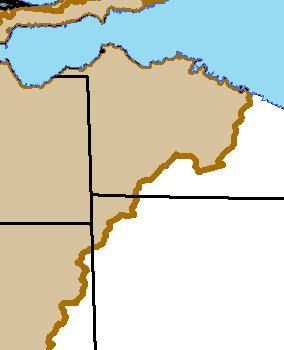


St.
St.


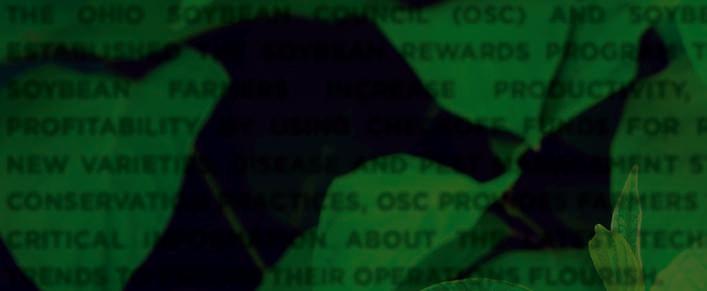


THE OHIO SOYBEAN COUNCIL (OSC) AND SOYBEAN CHECKOFF ESTABLISHED THE SOYBEAN REWARDS PROGRAM TO HELP OHIO’S SOYBEAN FARMERS INCREASE PRODUCTIVITY, YIELDS AND PROFITABILITY. BY USING CHECKOFF FUNDS FOR RESEARCH INTO NEW VARIETIES, DISEASE AND PEST MANAGEMENT STRATEGIES AND CONSERVATION PRACTICES, OSC PROVIDES FARMERS WITH THE MOST CRITICAL INFORMATION ABOUT THE LATEST TECHNOLOGIES AND TRENDS TO ENSURE THEIR OPERATIONS FLOURISH.

INVESTING IN THE FUTURE: RESEARCH DRIVES OHIO SOYBEANS OSC-FUNDED INNOVATIONS LEAD TO FARMERS’ SUCCESS
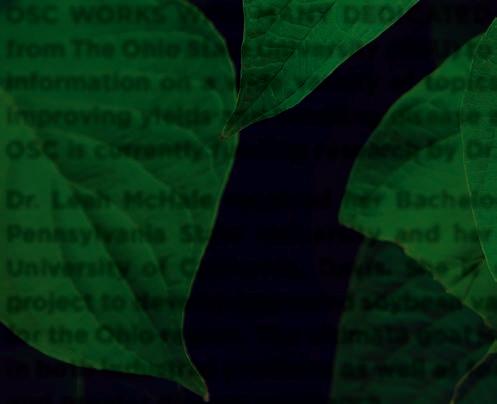

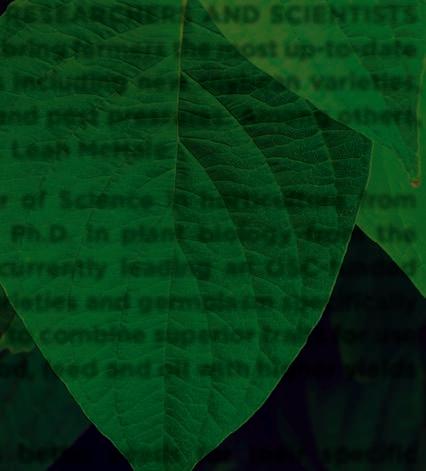

OSC WORKS WITH MANY DEDICATED RESEARCHERS AND SCIENTISTS from The Ohio State University (OSU) to bring farmers the most up-to-date information on a wide variety of topics including new soybean varieties, improving yields and handling disease and pest pressures. Among others, OSC is currently funding research by Dr. Leah McHale. Dr. Leah McHale received her Bachelor of Science in horticulture from Pennsylvania State University and her Ph.D. in plant biology from the University of California, Davis. She is currently leading an OSC-funded project to develop improved soybean varieties and germplasm specifically for the Ohio region. The ultimate goal is to combine superior traits for use in both industrial products as well as food, feed and oil with higher yields and greater disease resistance. What this means for Ohio farmers is better seeds for their specific environment. Better seeds mean better soybeans, which leads to bigger profits, increased market share and even opening up some new markets.


THE UGLY TRUTH ABOUT SUDDEN DEATH SYNDROME
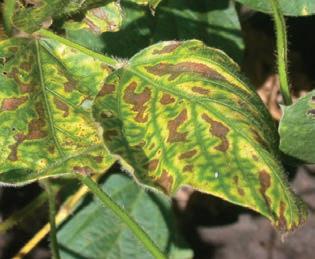



FIRST APPEARING IN 1971, sudden death syndrome (SDS) has become a problem in almost every U.S. soybeanproducing state. It is a fungal disease that favors wet, poorly drained and compacted fields. High rainfall seasons also can contribute to the flourishing of SDS.

TYPICAL SYMPTOMS INCLUDE:
• LEAF DROP
• DISCOLORED AND/OR DECAYING ROOTS AND CROWNS
• YELLOW SPOTS ON THE TOP LEAVES
• BROWN LESIONS THAT SPREAD UNTIL THE LEAF IS DEAD

1. 2. 3.

TOP 3 METHODS TO MANAGE SDS

CHOOSE VARIETIES WITH HIGH LEVELS OF RESISTANCE TO THIS PATHOGEN. RESISTANT VARIETIES ARE AVAILABLE AND ARE VERY EFFECTIVE.
DON’T PUSH THE PLANTING. THIS FUNGUS FAVORS WET, COOL CONDITIONS, SO PLANT FIELDS WITH A HISTORY OF SDS LAST AND UNDER DRIER CONDITIONS.
DON’T COMPACT FIELDS. COMPACTION KEEPS SOIL MOIST FOR A LONGER PERIOD OF TIME, PROVIDING A LONGER TIME FOR INFECTION.

For the rest of this list, please go to www.soybeanrewards.org or for more information, please contact Dr. Anne Dorrance at dorrance.1@osu.edu.


Photo: University of Illinois
Building Membership and Grassroots Advocacy
OSA Encourages Fertilizer Applicator Certification
The Agricultural Fertilizer Applicator Certification Program administered by the Ohio Department of Agriculture (ODA) became law last summer. As a result, the program requires training, application for the certificate and continuing education to maintain the certificate. Those required to obtain the certificate prior to September 30, 2017, are anyone applying fertilizer to 50 or more acres of agricultural production. Agricultural production means the cultivation, primarily for sale, of plants or any parts of plants, excluding start-up fertilizer. Farmers and commercial fertilizer applicators that already have either a commercial or a private Pesticide Applicator License issued by ODA are required to attend a two-hour minimum training session. These are often being held on the same day as Pesticide Applicators Recertification sessions. Farmers and commercial applicators that need an Agricultural Fertilizer Applicator Certification, but do not have a pesticide license, need to attend a three-hour training session. Training is provided by Ohio State University Extension.
A complete listing of these programs is available at www.pested.osu.edu/ NutrientEducation. If you are interested in attending these programs please preregister due to seat limits at training locations. Individuals who hold a current Certified Crop Advisors or Certified Livestock Manager professional certification are exempt from the training but must apply for the Agricultural Fertilizer Applicator Certification through ODA. The following is a list of common questions regarding the program.
Who needs a fertilizer certification?
Fertilizer certification is required if you apply fertilizer (other than manure) to more than 50 acres of agricultural production grown primarily for sale. If you have the co-op or other custom applicator make your fertilizer applications, you do not need the certification.
What fertilizer is included in the certification?
Fertilizer is any substance containing nitrogen, phosphorus, potassium, or other plant nutrient in a dry or liquid formulation. All application types (broadcast, side-dress, sub-surface, knifing, etc.) are included in the

certification requirement. The only application exempted is start-up fertilizers that are applied through a planter. For this certification requirement, lime and limestone are not considered fertilizers.
Who is exempt from the training requirement?
Applicators who are a Certified Crop Advisor (CCA) or Ohio Certified Livestock Manager are not required to attend training to become certified for fertilizer applications.
When do I need the certification?
The certification must be obtained by September 30, 2017.
What training is required for the certification?
Farmers and applicators need to attend a training course offered by Ohio State University Extension to become certified. Those who have a pesticide applicator license need to attend a twohour fertilizer certification for private applicators or for commercial applicators. If an applicator does not have a pesticide license, they will be required to attend a three-hour fertilizer certification.
How much is the agricultural fertilizer certification?
The agricultural fertilizer certification is $30 for a three year certification. If an applicator already has a valid pesticide license, the $30 fertilizer certification fee will be waived.
For more information, visit www.pested. osu.edu/NutrientEducation. u
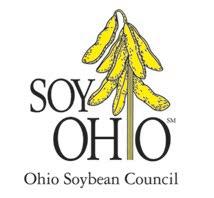
An Alliance for Ohio Soybean Farmers
The Ohio Soybean Council and the Ohio Soybean Association are two distinct organizations that work together to ensure a profitable industry for Ohio soybean farmers.
The Ohio Soybean Council (OSC) manages the soybean checkoff. Your checkoff funds help drive demand and boost your bottom line through research, promotion and education.
On average, for every dollar the checkoff invests, you see a $6.40 return on investment.
Nationwide, the checkoff plans to invest over $9 million in research aimed at proteching and increasing yields to 59.5 bushels per acre by 2030.
OSC invests in the following areas:
• Soybean Research
• Soy-based Products/Technologies
• Animal Agriculture
• Global Utilization
• Critical Infrastructure
• Sustainability
Connect with us
▶ Facebook.com/ohiosoybeancouncil
▶ Twitter.com/ohiosoycouncil
▶ Subscribe to the Ohio Soybean Council e-News letter. Visit soyohio.org
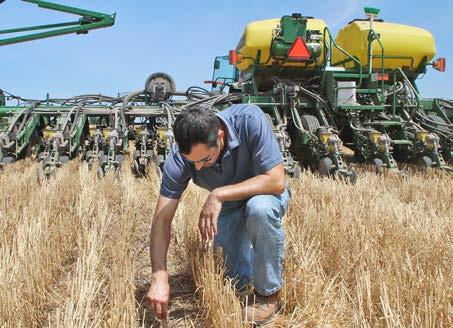

The Ohio Soybean Association (OSA) is a grassroots, membership organization. Because the soybean checkoff is prohibited by law from lobbying, OSA works to ensure that sound policies are in place to enhance the future of soybean farming. We work together to positively impact regulatory and legislative issues on a local, state and national level.
Are these issues affecting your operation?
• Farm Bill
• Water Quality/Nutrient Management
• Crop Insurance Concerns
• Transportation
• EPA Regulatory Oversight
• Foreign and Domestic Market access
When our membership grows, so does your voice in Columbus and Washington, D.C. Join today: www.soyohio.org/membership
Connect with us
▶ Twitter.com/ohsoybeanassoc
▶ Subscribe to the Ohio Soybean Association e-News for policy updates and more. Visit soyohio.org

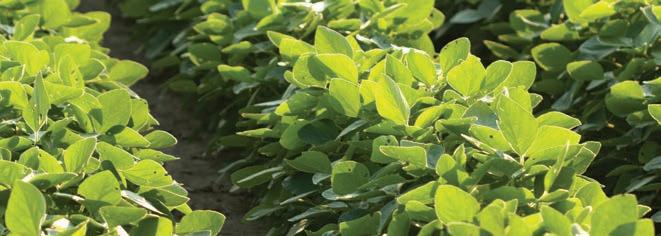
SOY TALK
A new era of weed control is here
The Enlist™ Weed Control System is an advanced herbicide and trait system that delivers exceptional weed control.
Dave Hillger, PhD, an Enlist field specialist with Dow AgroSciences, offers a closer look at the system: Enlist traits, Enlist Duo™ herbicide with Colex-D™ Technology and the Enlist™ Ahead management resource.
Enlist traits in elite soybean varieties
Enlist traits give soybeans tolerance to Enlist Duo herbicide, a proprietary blend of new 2,4-D choline and glyphosate. In addition, Enlist soybeans and Enlist E3™ soybeans offer more weed control options in one convenient system, including tolerance to glufosinate herbicides.
In future seasons, Enlist soybeans will be available in elite varieties from Mycogen Seeds. As always, yield performance remains the primary focus for all new products. Dow AgroSciences has many years of yield data showing no yield penalty associated with Enlist™ traits.
Proven performance of Enlist Duo herbicide
The two modes of action in Enlist Duo work within a program approach to deliver season-long weed control and help prevent weed resistance. Growers can maximize yields by eliminating nutrientrobbing weeds from their fields.
The innovations introduced with Colex-D™ Technology help growers and applicators address challenges beyond controlling tough weeds. This powerful new herbicide offers four key benefits – ultra-low volatility, minimized potential for physical drift, low odor and improved handling characteristics.
The drift reduction from Colex-D Technology combines with low-drift nozzles to cut drift by as much as 90 percent compared with a tank mix of traditional 2,4-D and glyphosate. In addition, near-zero volatility — up to 96 percent less than traditional 2,4-D — helps keep Enlist Duo™ in place to improve control.
Enlist Aheads helps manage and prevent resistance
The system also includes Enlist Ahead, a benefits-based management resource to help growers and applicators get the best results from the Enlist system — today and in the future.
“Ultimately, the Enlist system is going to offer growers peace of mind and a great weed management package to maximize yield potential,” says Hillger.
Brought to you by:
™®Colex-D, Enlist, Enlist Duo, Enlist E3 and the Mycogen Seeds Logo are trademarks of The Dow Chemical Company (“Dow”) or an affiliated company of Dow. ®Roundup Ready is a registered trademark of Monsanto Technology LLC. Enlist E3 soybeans are jointly developed by Dow AgroSciences and MS Technologies. Regulatory approval is pending for Enlist cotton. Enlist Duo herbicide is not registered for sale or use in all states. Contact your state pesticide regulatory agency to determine if a product is registered for sale or use in your state. Always read and follow label directions. ©2015 Mycogen Seeds. Mycogen Seeds is an affiliate of Dow AgroSciences LLC.
GMO Labeling Bill Would Provide Clarity
The American Soybean Association (ASA) issued its firm support for a bill introduced and referred to the House Energy and Commerce Committee that would provide for a national labeling standard for non-GMO foods. The bill, brought forward by Reps. Mike Pompeo of Kansas and G.K. Butterfield of North Carolina, bypasses a potentially conflicting patchwork of state laws and regulations governing the labeling of GMO and non-GMO foods, as well as multiple private sector non-GMO labeling standards, by establishing one common framework for labeling at the national level.
At the retail level, consumers who want to choose non-GMO foods have to contend with an increasingly confused landscape of different labeling schemes with different requirements.
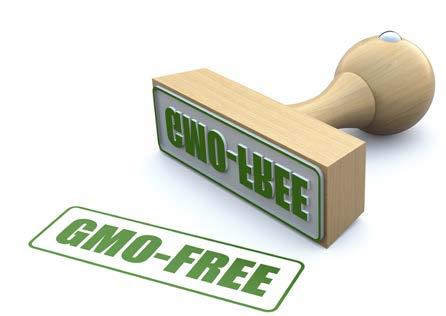
“This bill would end confusion for consumers over which food products do not contain biotech ingredients by establishing a national standard for non-GMO labels,” said Wade Cowan, ASA president and West Texas-based farmer. “That way, all of the products in the grocery store that don’t contain GMOs will have one simple, easy-to-understand label on them, and the consumer gets the information he or she is looking for.”
In addition to provisions for a national non-GMO label, the bill would also solve the problem created for consumers, farmers and retailers by the inconsistent patchwork of potential state regulations governing the labeling of GMOs. The bill also helps to provide consumers with greater clarity by replacing state laws and regulations that can be at odds with one another with a clear and simple national labeling standard.
“We know that labeling at the state level will only disrupt interstate commerce and result in increased costs to consumers since food companies would need to label products to meet potentially 50 different labeling requirements,” added Cowan. “Moreover, there is near unanimous agreement among members of Congress – including both liberal Democrats and conservative Republicans – that a patchwork of conflicting state labeling laws is unworkable and would only increase consumer costs.” u
*Article provided by the American Soybean Association

YOU WERE MEANT FOR THIS.
When all the planting, feeding and protecting grow into more than just your yield. More than a job well done — it’s a realization. That this is what you were meant to do. We’re with you. It’s what Mycogen Seeds is all about. A shared passion for the life of your land. For the life that you love.
Visit to maximize the potential of your corn and soybeans.
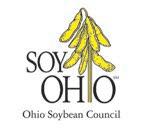
Fueling the Biodiesel Market
Higher blends of biodiesel are popping up more frequently at fuel stations as approval grows, but availability remains somewhat regional.
More equipment manufacturers support biodiesel than ever before, and as the industry continues to provide more advanced biofuels to the diesel market the Ohio Soybean Council (OSC) and soybean checkoff is helping fuel that growth.
The U.S. biodiesel industry contributed nearly five percent of the on-road diesel market each of the last two years with 1.8 billion gallons in 2013 and 1.75 billion gallons in 2014, despite recent industry challenges.
OSC supports several projects with the National Biodiesel Board (NBB) that are designed to get 100 percent of auto and engine manufacturers to approve higher biodiesel blends in their vehicles. Currently, around 75 percent of the light duty manufacturers — passenger cars and pickup trucks — approve of the use of B20 with about 90% approval on heavy duty trucks. The projects should either give manufacturers the confidence they need to award approval or at least offer additional information to see where design improvements are needed.

Biodiesel blends up to five percent — commonly referred to as B5 — can currently be sold as diesel fuel and used most anywhere and anytime diesel fuel is used in an engine. The opportunity for growth exists in getting widespread approval for the blends above five
percent, and more significant gains could be seen with additional approval from locomotive manufacturers.
“Whether it’s light duty cars and trucks, medium to heavy trucks or eighteen wheelers, everybody approves the use of B5,” said Scott Fenwick, who
serves as the technical director for NBB. “So what we’re working on are the higher blends. We recently received approval for blends up to 20 percent — B6 to B20 — to be used in heating oil that is consumed here in the U.S.”
Another focus for NBB is working closely with auto and engine manufacturers across the country to approve higher blends for use in their product lines. Ford and General Motors (GM) are at the forefront of this effort having already approved B20 for use in all of their newer vehicles from here forward. A biodiesel stability project in partnership with OSC is hoping to expand that approval.
“We are in the process of completing a biodiesel stability project working with Ford, GM, Volkswagen, Mercedes, and truck and engine manufacturers,” said Fenwick. “We recently tested several vehicles at the Volkswagen proving grounds in Arizona this past summer and the goal was to look at extreme heat applications. As if the vehicle were to sit in the hot sun for lengthy periods of time with minimal driving activity what would the effect be on that fuel in the vehicle and on the fuel system.”
designed to move toward cleaner, more environmentally friendly fuels.
“There certainly are states and regions that are adopting higher blends at a higher rate,” said Fenwick. “Minnesota currently has a B10 mandate for most of the year and states such as Illinois have an incentive program where blends higher than 10 percent have no state motor fuel tax. So that’s a strong enough incentive that there’s significant amounts of blending.”
manufacturers are GE and EMD — Electro-Motive Diesel — and they both approve blends up to B5 and we’re working with them on higher blends as well.”
The locomotive industry tends to lag behind the auto industry in the fuel sector being the last major sector to use ultra-low sulfur diesel. Many of the same studies used for the automotive market are explained to the railroad companies first before more specialized projects are designed to provide the information they need to be confident in the approval of higher biodiesel blends.
“Biodiesel stands out among alternative fuels as a U.S. product made from

Biodiesel and petroleum diesel fuel age a little bit differently and as a result biodiesel has a stability requirement in the B100 specifications. The requirement is designed so that the minimum for B100 will suffice for all blends with petroleum diesel. Preliminary results look as though the specification set for B100 is sufficient for extreme hot weather applications of biodiesel blends up to B20.
Along with support from engine manufacturers, biodiesel industry growth can also be linked to state policies
Biodiesel is also a strong part of initiatives in California and Oregon where low carbon fuel regulations are being introduced or have been passed. OSC has also provided support for studies to bring railroads on board with biodiesel as they are the third largest consumer of diesel in the U.S.
Biodiesel blends up to 20% have slightly more approval from heavy truck manufacturers but are making significant gains in the personal auto market as well with cars and light trucks.
“We’re working with the locomotive manufacturers and the railroad companies themselves on the mission to expand and increase the use of biodiesel and higher biodiesel blends just like on the transportation fuel market,” said Fenwick. “The two largest locomotive
renewable resources, including soybeans,” said Amy Sigg Davis, OSC board member and soybean farmer from Warren County. “It provides domestic energy security and is much cleaner from an emissions standpoint by reducing carbon, sludge, and particulate matter that are traditionally emitted by the engines.” u

Investing Checkoff Dollars
Battelle’s Inventor of the Year Key Researcher for OSC
Many of the research efforts backed by the Ohio Soybean Council (OSC) and soybean checkoff focus on the development of new technologies and products that showcase the unique qualities of soybean components. Often times, Ram Lalgudi is the face behind those breakthroughs.
Innovative, forward-thinking and determined are just a few of the words that can be used to describe Lalgudi. At Battelle, the world’s largest nonprofit research and development organization, they have also named him “Inventor of the Year.”

Lalgudi is a senior research scientist at Battelle and holds a doctorate in polymer chemistry from the National Chemical Laboratory, India. He has received wide recognition over his 13-year tenure with Battelle for his work with coatings, adhesives, composites, membranes, encapsulation and medical products.
“Being named Inventor of the Year at Battelle is more than just an honor, it’s a high point of my professional life,” Lalgudi said. “Significant credit for my achievement should go to Ohio soybean farmers. Their focus on developing innovative products based on soybean components is the key for my research inspiration. I feel blessed to work on OSC-funded projects and I know the products resulting from OSC research will significantly improve the quality of our life and the environment.”
OSC’s relationship with Battelle has allowed Lalgudi to play a key role in many of OSC’s projects, most recently with improved soybean meal for aquaculture and industrial BPA free coating for the packaging industry.
“Ram Lalgudi has played an important leadership role in the research and development of soy biobased products for OSC. We value Ram’s innovative approach of seeking industry input to help guide his research to ensure that at the end of the day OSC and
Battelle have the highest probability of success,” said Patrick Knouff, OSC chairman and soybean farmer from Shelby County.
Lalgudi clearly has a firm grasp on the commercial market and finds solutions that meet the demands for commercial licensing and production. He has accumulated 12 granted US patents, 19 pending patent applications and has appeared in more than 25 publications for his developments.
Soy biobased products developed over the years by Lalgudi and other researchers at Battelle include soy based inks, coatings, plastics, hydrogels and most notable, a soy based polyol now widely used as a substitute for petroleum when making polyurethanes. Soy based polyol products are environmentally friendly and are often seen as superior to those produced with petroleum. u
Dr. Ram Lalgudi has played an instrumental role in the development of new soy-based products that have provided expanding markets for soybeans in Ohio and nationwide.
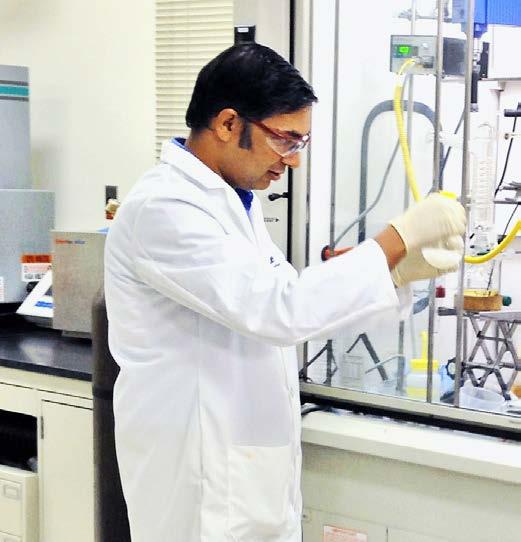
Ram Lalgudi

Investing Checkoff Dollars
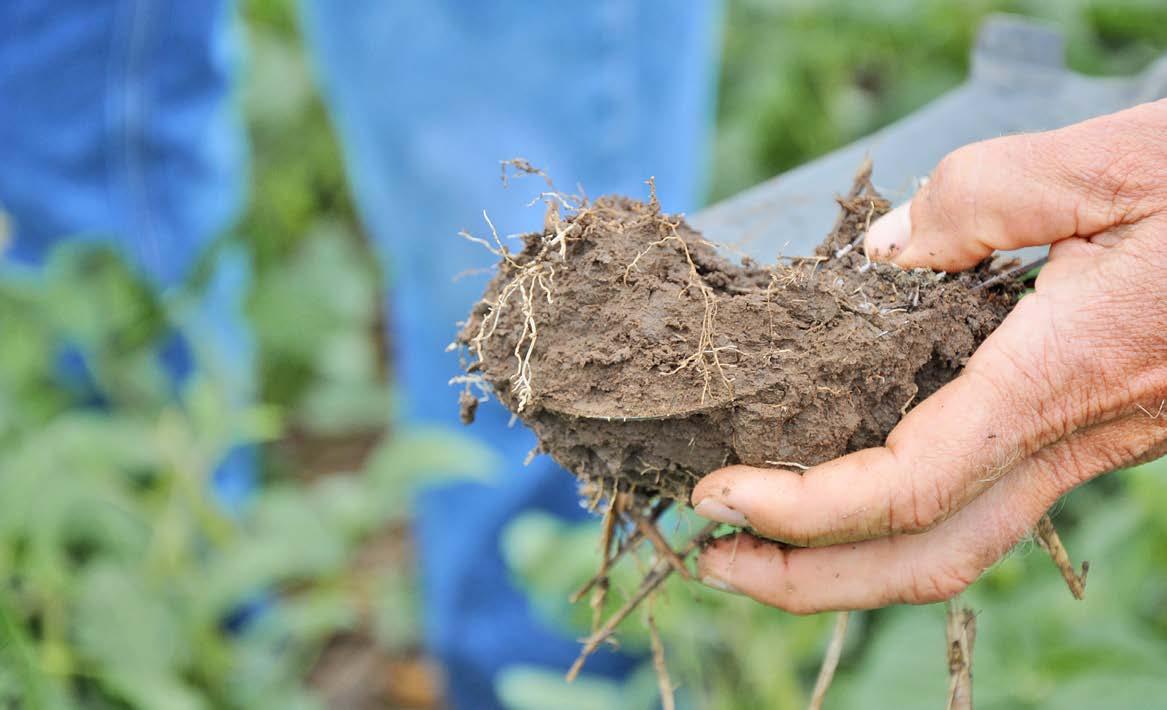
Redefining Ideal Soil Fertility
In 1995 The Ohio State University, in collaboration with Michigan State University and Purdue University, published fertility recommendations for field crops in the tri-state area. Over the last 20 years, a lot of things have changed; the fertility recommendations have not.
The issue at hand is that farmers are working off of standards that were set 20 years ago while they are able to utilize technology that is now advancing every year. New varieties with advanced traits may not require the same amount of certain elements. Looking at a decline in commodity prices and an increase in inputs, a relatively small adjustment could provide a little extra boost to farmers with tight profit margins in addition to allowing for better nutrient management practices.
“Recent events in Ohio have brought the issue of water quality to the forefront and put producers under a lot of pressure to update to better nutrient management practices,” said Gretchen Mossbarger, Chair of OSC’s research committee. “Research on soil fertility is a key component to allow growers as well as fertilizer applicators to be more precise and mindful in their use of nutrients.”
As researchers such as Steve Culman, a soil scientist from Ohio State, take to the field to collect data, farmer participation is in high demand.
“We are relying on farmer cooperation; if we don’t have a lot of buy-in from the agricultural community the success of this project is going to be limited,” said Culman. “What we need the most help with is trying to capture a wide diversity of soils, different management practices and their interactions. We’re trying to get robust information by going on farm and asking producers to put out strip trials where we can measure the response to fertilizer or the lack of fertilizer.”
Some major differences in common practices since 1995 and today include the popularity of notill, differences in row spacing and roundup ready soybeans. As researchers look to revalidate the recommendations, they’re focusing on two major nutrients for soybeans which are phosphorous and potassium.
“We often hear producers saying the tri-state recs aren’t relevant because they have really high yielding fields, but we want to test that; and we want to test low fertility fields,” said Culman. “We often have a hard time finding producers who want to work with us when their soils are below the critical level where we would expect a response to fertilizer. We are looking for soils that are low in phosphorous or potassium.” u

OSC Foundation Awards $36,000 In Scholarships
The Ohio Soybean Council Foundation (OSCF) believes in supporting education and scientific research by awarding several Ohio students scholarships on a yearly basis. Now in its eighth year, the OSCF scholarship program recently announced recipients for the 2015–2016 academic year. The program was created to encourage undergraduate students to pursue degrees in one of the many academic fields that support the future of the soybean industry including agriculture, business, communication, economics, education, science and technology as well as to support ongoing graduate-level research.
Undergraduate scholarships of $3,000 each were awarded to Jordan Bonham, Matt Klopfenstein, Summer McCracken, Jarret O’Neill, Emily Ratliff and Leah Schwinn. The annual Farmer, Lumpe + McClelland (FLM) Scholarship, awarded to students in the field of agriculture communications or business, was awarded to Meghan Bennett and Julianna Simon ($1,500 each). The annual $5,000 Bhima Vijayendran Scholarship, named in honor of a Battelle research scientist who has made tremendous contributions to the soybean industry, was awarded to Nathan Hager.
Two graduate scholarships of $5,000 were awarded to Ellie Walsh and Peipei Tang.
Undergraduate Winners:
Meghan Bennett OSU Houston, Ohio
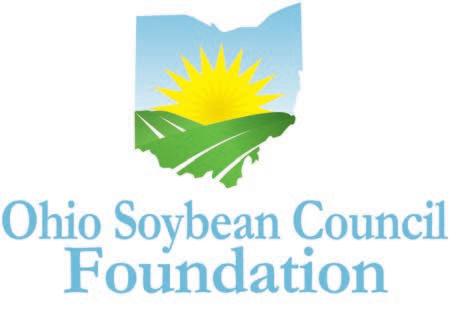
“Congratulations to the 2015–2016 OSCF scholarship recipients,” said Gretchen Mossbarger, OSC board member, soybean farmer from Ross County and scholarship selection committee member. “The program grows every year and the committee was extremely impressed with the amount of quality applications we received.”
To learn more about the OSCF and its programs, visit www.soyohio.org.
Graduate Winners:
Peipei Tang of Columbus, Ohio is pursuing a Ph.D. in food chemistry at The Ohio State University (OSU). His research focuses on incorporating soybean isoflavones into human diets, such as eggs. Soybean isoflavones can be transferred into and accumulated into egg yolks through the use of soy-based poultry diets.
Ellie Walsh of Shreve, Ohio is pursuing a Ph.D. in plant pathology at OSU. Her current research aims to alleviate the effects of organisms that have a negative impact on soybeans. She is focusing specifically on the interactions between soybean cyst nematodes and their host. u
Jordan Bonham OSU Washington Court House, Ohio
Nathan Hager OSU Wapakoneta, Ohio
Matt Klopfenstein OSU Haviland, Ohio
Summer McCracken OSU Anna, Ohio
Jarret O’Neill OSU Rockford, Ohio
Emily Ratliff OSU Greenfield, Ohio
Leah Schwinn OSU New London, Ohio
Julianna Simon Wilmington College Covington, Ohio
$1,500 Farmer, Lumpe + McClelland Scholarship
Bhima Vijayendran Scholarship
$1,500 Farmer, Lumpe + McClelland Scholarship










254 MILLION PRODUCED MORE THAN OF SOYBEANS THAT YIELDED AN AVERAGE OF




4.7 BUSHELS ABOVE THE NATIONAL AVERAGE OF 47.8 HARVESTED

4,840,000 ACRES BUSHELS IN SOYBEAN PRODUCTION ACROSS THE UNITED STATES PER ACRE



www.unitedsoybean.org PER ACRE IN THE NATION

Source: National Agricultural Statistics Service http://quickstats.nass.usda.gov/
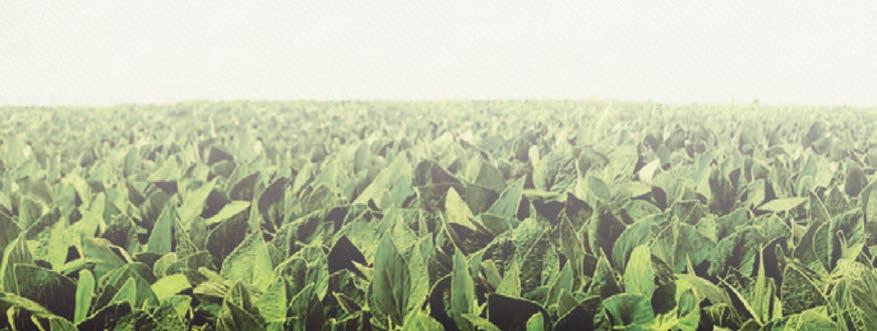


Breeding Better Beans
To those who are unfamiliar, a soybean is simply a soybean. Although anyone involved in production or processing in the soybean industry knows there are numerous varieties with intricate differences. Unique qualities of each variety can often be attributed to researchers who do the tedious work of isolating the genes for each desired quality, breeding them into a specific plant and running trials to ensure they are ready for high yielding production.
At The Ohio State University (OSU), research teams are focused on selective soybean breeding for pathogen resistance and specific traits to bring producers varieties that are more durable and specialized for specific markets as well as Ohio’s growing conditions.
“Here at OSU we have a program that focuses on identifying lines and germplasm that are actually resistant to the many pathogens attacking soybeans,” said Dr. Anne Dorrance, a professor and soybean pathologist at OSU. “From there, we characterize the resistance, how many
genes contribute to the expression and what conditions are necessary for the gene to appear.”
Dorrance works largely with water molds, a problem in clay soils where it can take two to three days for rainwater to drain off. In those conditions, the water molds produce swimming spores that can attack the plants. Another disease at the forefront is the same fungus that causes head scab in wheat which can attack soybean seedlings when there is a lot of inoculum present, possibly built up from years of growing susceptible crops in the same fields.
“That’s where our strengths are, those are the primary pathogens; and we have such a diversity of growing conditions here in the state that if something survives our program, they’ll probably survive anywhere,” said Dorrance.
To begin the process of developing host resistance, researchers have to find a variety that has a viable source — most often a soybean line with origins from Asia. These varieties are not suitable for Ohio production, but hold the
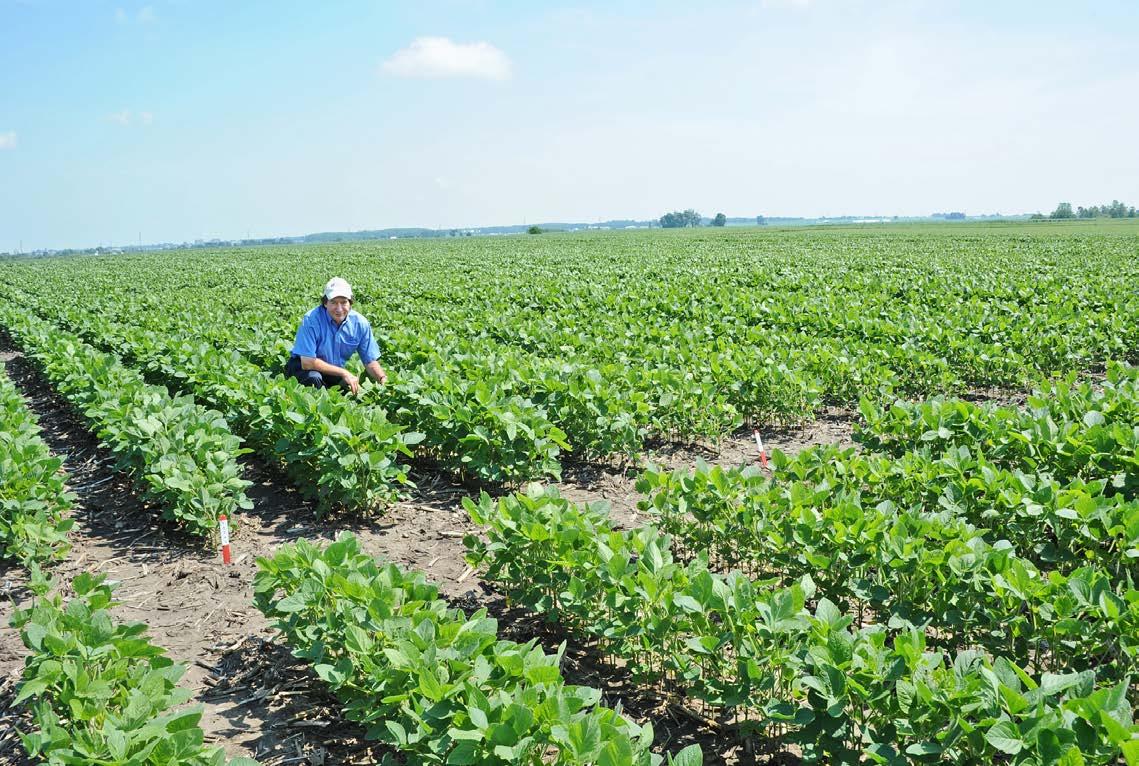
Field trials are carried out in different locations under a variety of growing conditions and practices.
genes for resistance that will be bred into the high yielding, adapted Ohio lines.
Currently, they are looking at some of the severe foliar pathogens and stem rot pathogens where host resistance — being environmentally friendly, easy to deploy and low cost to producers — is an efficient and viable option. Additionally, there is no chemical treatment for pathogens such as water molds and they may attack the crop all season long, making it very difficult to manage with other methods.
“With breeding, you have your crop that’s all ready to go,” said Dorrance. “We identify lines and in many cases map the traits so we know what markers to follow and we’ll send the line that we’ve already screened to Dr. McHale to do the crosses.”
Focusing on Ohio breeds, the research of Dr. Leah McHale, associate professor in the Department of Horticulture and Crop Sciences at OSU involves yield trials throughout the state to determine which varieties perform best. A large part of breeding is variety improvement by focusing on specific desirable traits — such as host resistance.
“We focus on a lot of specific traits — improvement of disease resistance, primarily for quantitative, or partial, disease resistance. It’s a trait that involves many different genes contributing a small part of the resistance and is usually considered non-race specific — meaning it will hold up against any race of the pathogen,” said McHale.
With race specific resistance, there may be another race of the pathogen that could overcome the resistant gene. Most cultivars McHale works with have race specific genes in addition to high levels of partial resistance as a built in failsafe. Selective breeding is not only used for host resistance with pathogens, but can be beneficial in dealing with soybean cyst nematode or soybean aphids and is a great way to develop varieties that more closely meet the needs of specialty markets.
“We have some preliminary phases — we carry out the cross, grow hybrids and then there’s a number of generations of inbreeding carried out so we can develop a uniform line — meaning the seeds from an individual plant will be genetically uniform.”
The inbreeding can take two to four years and is followed by three years of field evaluation in four Ohio locations. Each year the weaker material is weeded out and the resulting material is released through the Crop Variety Release and Distribution Committee. The committee is comprised of researchers, the office of technology and licensing, Ohio Foundation Seeds and Ohio Seed Improvement Association.
The many groups come together to collaborate on the best way to release the cultivars to get them into farmer’s fields — whether it is released as a public, branded, exclusive or nonexclusive cultivar.
In addition to releasing cultivars, there are research and educational components being supported along the way.
“Our research components help us understand the mechanisms, how these traits that we’re breeding for are
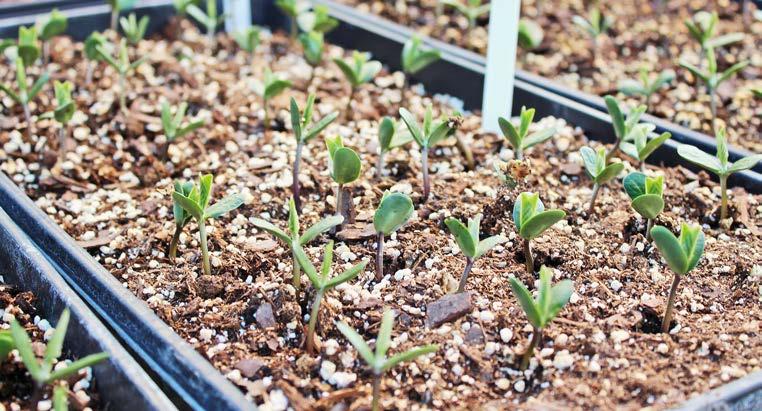
“The primary specialty market we work with is the food grade market which consists of developing soybeans for people, as opposed to the crush market for oil and meal,” said McHale. “We work mostly with the soymilk and tofu markets that typically look for high protein, large seeded, clear hilum, smooth seed coats and seed coats free from cracking. More visual characteristics are important for that market.”
Other varieties in development include high oleic with high oil traits, looking at high oleic currently being a smaller and higher value market, the combination with high oil will provide a better value. They are also looking at some specialty oil types in anticipation of specialty products becoming available in the future and knowing the process to get the varieties on the market can take time.
“Our process can range from six to eight years from the time we conduct crosses to the time we release the material,” said McHale.
Host resistance is extremely important to soybean seedlings as they are especially susceptible to pathogens.
controlled genetically and ultimately predict how useful it’s going to be when it’s deployed in the field so we don’t get surprised down the road,” said McHale.
The Ohio Soybean Council and soybean checkoff not only allocates funds for these research goals, but also provides a source of farmer feedback and a direct connection to issues producers are facing.
“We support the work at Ohio State because we recognize its importance. They are providing solutions to producer problems and advancing the markets for Ohio soybeans all while supporting research and teaching goals that will provide the next generation of plant scientists for our industry,” said Patrick Knouff, OSC Chairman and soybean farmer from Shelby County. u

Investing Checkoff Dollars
USB Fellowship Awarded To OSU Student
While soybeans are a common crop grown in many parts of the world, they remain a complex research subject for many plant scientists. To encourage the next generation to take interest in soybean research, the United Soybean Board (USB) awards fellowships each year to graduate students who demonstrate an interest and great potential for advancing the science behind soybean improvement.
One of the recent fellowships was awarded to an Ohio State grad student, Anna Stasko, who is working toward a doctorate degree in Plant Pathology.
The research Stasko is involved in — along with her advisor, Dr. Anne Dorrance — focuses on isolating the individual genes that contribute to pathogen resistance. In particular, she is working on partial resistance to Phytophthora sojae, a soil-borne pathogen that develops in soils that are saturated soon after planting and exhibits more in heavy or clay soil types. The pathogen causes root rot and is one of Ohio’s largest contributors to soybean yield loss each year. While there are single genes used for complete resistance, the pathogen is now able to overcome many of those, and partial resistance would serve as a built-in safety net.
“Partial resistance is considered to be more durable; you have a lower rate of disease. Even under high disease pressure you can still get good yields,” said Stasko. The goal with my research is going back through the parts of the genome we have found that are protecting the plant and try to find the individual genes that are actually involved.”
Stasko’s interest in science began at a young age and was fostered through high
school biology classes and a summer job at a seed company after high school.
“I knew from high school biology I was interested in genetics — looking at genes and how they work,” said Stasko. “In college, I found out about the opportunity to research with the USDA and spent three summers doing work in their plant pathology labs. For me, it was really the first time my interests in plants,
to support PhD graduate students who are doing their research in some area of soybean science and have the intention to pursue a career in soybean sciences, production research or breeding.”
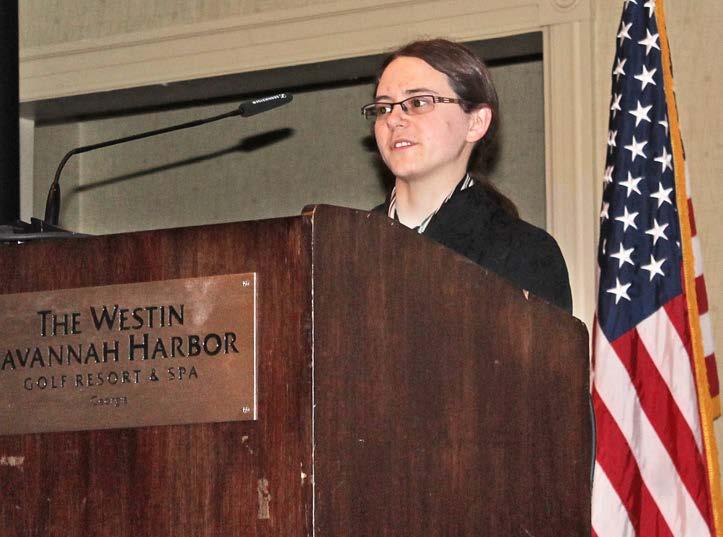
genetics and disease all came together and I realized I wouldn’t have to go to medical school to still do research that would have a meaningful impact.”
According to Neal Hageman, who serves as the research director for USB, “The fellowships are designed
The fellowship provides a stipend for Stasko and allows the department to put their other resources toward furthering research and broadening their reach. Once Stasko completes her doctorate degree she hopes to pursue a faculty position that will allow her to continue agricultural research that connects with what is happening on farms today while reaching out to a wider audience with students. u
Anna Stasko, graduate student at The Ohio State University accepts the USB Fellowship Award during the USB meeting.


The 2015 Ohio State Fair runs July 29–August 9. The Ohio Soybean Council will be:
A presenting sponsor of the 2015 Ohio State Fair
A presenting sponsor of the 2015 Livestock shows, the O’Neill Swine Building, Voinovich Livestock and Trade Center and Rabbit & Poultry Pavilion JOIN THE FUN!
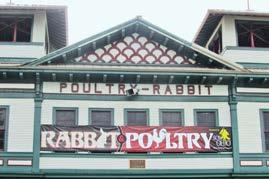

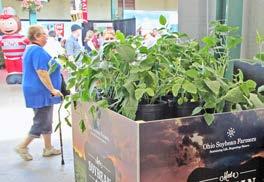

SOYBEAN DAY AT THE FAIR Saturday, August 8th, 2015
This voucher allows one FREE admission per household to an Ohio soybean farmer or an Ohio Soybean Association member, and $4 admission to each family member in their party on Ohio Soybean Day at the Fair, Saturday, August 8th, 2015.
A Change of Seasons



